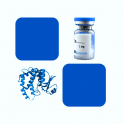
- Remove this product from my favorite's list.
- Add this product to my list of favorites.
Products
Newsletter
 |  |  |  |  |  |

Background
Dipeptidyl peptidase-IV (DPPIV), also known as adenosine deaminase complexing protein 2, DPPIV or CD26 is antigenic enzyme expressed on the surface of most cell types and is associated with immune regulation, signal transduction and apoptosis. It is an intrinsic membrane glycoprotein and a serine exopeptidase that cleaves X-proline dipeptides from the N-terminus of polypeptides.(1) The substrates of DPPIV are proline (or alanine)-containing peptides and include growth factors, chemokines, neuropeptides, and vasoactive peptides.(2) DPPIV plays a major role in glucose metabolism. It is responsible for the degradation of incretins such as GLP-1.(3) DPPIV plays an important role in tumor biology, and is useful as a marker for various cancers, with its levels either on the cell surface or in the serum increased in some neoplasms and decreased in others.(4) DPPIV also binds the enzyme adenosine deaminase specifically and with high affinity. The significance of this interaction has yet to be established.
Source
Recombinant Human DPPIV /DPP4 /CD26 Protein, Tag Free (DP4-H5211) is expressed from human 293 cells (HEK293). It contains AA Asn 29 - Pro 766 (Accession # NP_001926.2).
Molecular Characterization
This protein carries no "tag".
The protein has a calculated MW of 85.5 kDa. The protein migrates as 90-116 kDa when calibrated against Star Ribbon Pre-stained Protein Marker under reducing (R) condition (SDS-PAGE) due to glycosylation.
Endotoxin
Less than 1.0 EU per μg by the LAL method.
Purity
>95% as determined by SDS-PAGE.
>95% as determined by SEC-MALS.
Formulation
Lyophilized from 0.22 μm filtered solution in 50 mM HEPES, 150 mM NaCl, pH7.5 with trehalose as protectant.
Reconstitution
See Certificate of Analysis for details of reconstitution instruction and specific concentration.
Storage
For long term storage, the product should be stored at lyophilized state at -20°C or lower.
Please avoid repeated freeze-thaw cycles.
This product is stable after storage at:
-20°C to -70°C for 12 months in lyophilized state;
-70°C for 3 months under sterile conditions after reconstitution.
Bioactivity
Please refer to product data sheet.
(1) "The In Vitro Inhibitory Activity of Pacaya Palm Rachis versus Dipeptidyl Peptidase-IV, Angiotensin-Converting Enzyme, α-Glucosidase and α-Amylase"
Bernardino-Nicanor, Fernández-Avalos, Juárez-Goiz et al
Plants (Basel) (2024) 13 (3)
(2) "Olive (Olea europaea L.) Seed as New Source of Cholesterol-Lowering Bioactive Peptides: Elucidation of Their Mechanism of Action in HepG2 Cells and Their Trans-Epithelial Transport in Differentiated Caco-2 Cells"
Bartolomei, Li, Capriotti et al
Nutrients (2024) 16 (3)
(3) "A discovery of potent kaempferol derivatives as multi-target medicines against diabetes as well as bacterial infections: an in silico approach"
Parveen, Shehzadi, Shafiq et al
J Biomol Struct Dyn (2024)
Showing 1-3 of 1914 papers.
Follow us